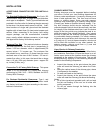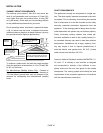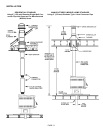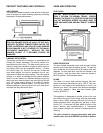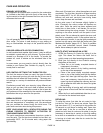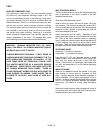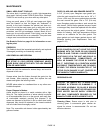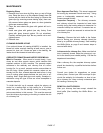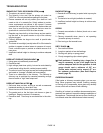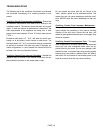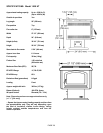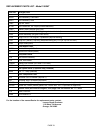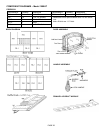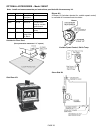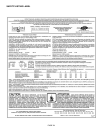MAINTENANCE
PAGE 17
Replacing Glass:
1. Remove door from stove by lifting door up and off hinge
pins: Place the door on a flat protected (towel) clean flat
surface with the inside of the door facing up. Remove the
glass clips (by removing screws holding clips), then care-
fully remove broken glass one piece at a time (protective
gloves are recommended).
2. Clean the area where the glass with gasket will be in-
stalled.
3. Install new glass with gasket (use only factory 5-mm
glass with glass channel gasket. Do not substitute).
Carefully reinstall glass clips. Be very careful not to over-
tighten screws.
4. Reinstall door.
CLEANING BLOWER INTAKE
If an optional blower kit (catalog #14M22) is installed, the
blower air intake requires cleaning at least once a year to
remove lint, dust, etc. If there are pets in the dwelling, the
intake should be cleaned at least twice a year.
CREOSOTE FORMATION AND NEED FOR REMOVAL
What is Creosote - When wood is burned slowly, it pro-
duces tar and other organic vapors, which combine with
expelled moisture to form creosote. The creosote vapors
condense in the relatively cool chimney flue of a slow-
burning fire. As a result, creosote residue accumulates on
the flue lining. When ignited this creosote makes an ex-
tremely hot fire. Also, creosote deposits tend to form in long
runs of venting where gases become too cool prior to ex-
hausting. Note: Single wall pipe cools rapidly, therefore in-
stallations using this type of flue are more susceptible to
creosote deposits.
To inhibit the build up of creosote, adjust the primary air
control to a medium-high or high setting for a 10-minute
period each day. Do not attempt to burn out heavy creo-
sote accumulations in this manner. This must be removed
from the chimney by scraping or brushing to reduce the risk
of a chimney fire.
Burn Approved Fuel Only - This stove is approved
for burning dry seasoned natural wood only. Using
green or inadequately seasoned wood may in-
crease creosote buildup.
Inspection Frequency - The chimney connector
and chimney should be inspected at least twice
monthly during the heating season to determine if a
creosote buildup has occurred. If creosote has ac-
cumulated it should be removed to reduce the risk
of a chimney fire.
Cleaning - Remove the brick baffle in the firebox
prior to having your chimney cleaned (should be
done by a qualified chimney sweep). See Installing
the Baffle Bricks on page 8 and reverse steps to
remove baffle brick).
In the event of a chimney fire - Make sure the fuel
door is securely closed. Adjust the primary air con-
trol to the lowest (most closed) setting. Call the fire
department immediately.
After a chimney fire, the complete chimney system
should be checked by a qualified technician before
further use.
Consult your dealer for suggestions on proper
chimney care. Contact your local municipal or pro-
vincial fire authority for information on how to han-
dle a chimney fire. Have a clearly understood plan
for handling a chimney fire.
REINSTALL BAFFLE BRICK
After your chimney has been swept, reinstall the
brick baffle (See Installing the Baffle Bricks on
page 8).



